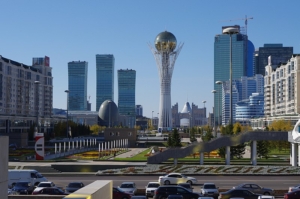How Foreign Investment in Kazakhstan Fights Poverty
 Kazakhstan is a Central Asian nation of almost 20 million people and is the second-largest former member of the USSR. According to the World Bank, it has a GDP per capita of $11,494.30 which is significantly larger than the surrounding countries. The Global Poverty & Equity Brief reports that, as of 2021, the poverty rate is 5.2%. Alongside its neighbors, Kazakhstan is abundant in resources like oil, gas, coal and uranium and capitalizes on these supplies for economic growth.
Kazakhstan is a Central Asian nation of almost 20 million people and is the second-largest former member of the USSR. According to the World Bank, it has a GDP per capita of $11,494.30 which is significantly larger than the surrounding countries. The Global Poverty & Equity Brief reports that, as of 2021, the poverty rate is 5.2%. Alongside its neighbors, Kazakhstan is abundant in resources like oil, gas, coal and uranium and capitalizes on these supplies for economic growth.
Although Kazakhstan is experiencing steady economic growth and paints itself as the most developed and reformed Central Asian country, corruption and an unorganized government exacerbate poverty. Foreign investment in Kazakhstan can alleviate these issues and potentially solidify its position as the strongest nation in the region.
Kazakhstan’s Economic Picture
As things stand, Kazakhstan holds a predominant position in the region. It connects the South Asian market to the markets of Russia and the EU with railways and ports. For Western producers, Kazakhstan opens access to “100 million consumers in Caspian Sea countries, 76 million in Central Asia and 350 million in Western China,” according to the U.S. Department of Commerce’s International Trade Administration (ITA).
Furthermore, the ITA believes that it provides potential for US agricultural markets, as Kazakhstan’s growing middle class opens more opportunities for U.S. investment. In turn, this global financial involvement in Kazakhstan further expands the middle class and decreases poverty.
Most notably, Kazakhstan capitalizes on its natural resources to make 58% of all exports. Through the shipment of oil, natural gas, iron, copper and uranium, Kazakhstan trades with China, Italy, Russia, the Netherlands, Uzbekistan, India, Turkey and France. Trade with the United States (U.S.) accounts for just more than 1% of its exports.
Over the course of 2023, real GDP is expected to increase by almost 4%, an increase over the 3.2% growth in 2022.
International Involvement
Kazakhstan receives the most foreign direct investments in Central Asia, something both expected of and attributed to its relative economic strength in the region.
Kazakhstan established the Astana International Financing Center (AIFC) in 2018 to attract countries and companies to invest in the region. The AIFC offers financial and legal support to investors and promotes environmentally sustainable development. This initiative encourages green foreign investment in Kazakhstan, which can help boost the domestic economy and create more job opportunities, ultimately helping in the fight against poverty.
Furthermore, the Overseas Security Advisory Council (OSAC) is a U.S. organization that cooperates with businesses and universities to further integrate the U.S. and its mission with different countries in the world. Kazakhstan’s specific OSAC mission predominantly aims to establish U.S. security connections but also aims to strengthen financial involvement between the two nations. Specifically, it allows for the creation of the Special American Business Internship Training Program (SABIT).
The U.S. Department of Commerce labels SABIT as a program that endorses and facilitates fair economic trade between the U.S. and Kazakhstan. As of 2023, the program has enabled more than 470 Kazakhstani business leaders to gain first-hand experience with American business models. This training is highly individualized and specific to each business and creates connections between equivalent businesses in the two countries. Although mostly pertaining to private corporations, the governments occasionally interact to integrate the markets. Since the program’s inception in 1990, the total generated amount from the region is more than $1 billion. As of 2021, all SABIT interactions in Central Asia have focused on renewable energy. With this shift in focus and general improvement of business practices, SABIT helps improve the Kazakhstani economy and alleviates domestic poverty.
Resilience to Geopolitics
Kazakhstan is invested in geopolitical relationships but is structured to not face major influence from world events. The World Bank reports that Russia’s economic downturn as a result of the Ukraine War will in fact derail Kazakhstan’s supply chains and weaken trade. This is further exacerbated by the fact that Kazakhstan’s main oil pipeline (providing 80% of Kazakh oil) was damaged in the Russian Black Sea terminal. Nonetheless, rising oil costs have made oil exports more valuable and reduced Kazakhstan’s current account deficit by almost 1% as of 2021.
In response to sanctions surrounding Russia, Kazakhstan has expanded trade partners and sought out partnerships in East Asia, especially through China’s Belt and Road initiative. By cementing itself in intercontinental routes like the Trans-Caspian International Transport Route from South Asia to Europe, Kazakhstan ensures that it will forever benefit from global trade.
Foreign investment in Kazakhstan is becoming significantly more common and important as the country proves itself to be receptive to and valuable for international investors. With Kazakhstan’s increasing integration with the global economy, there will be a growth in the labor force and a potential decline in poverty levels.
– Sahib Singh
Photo: Wikimedia
